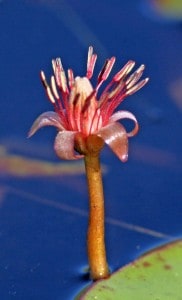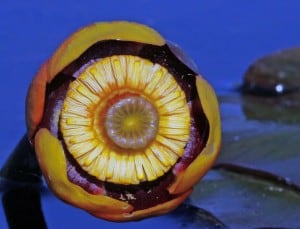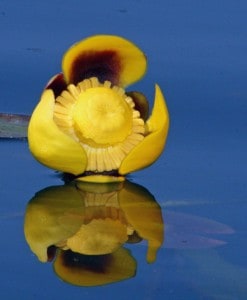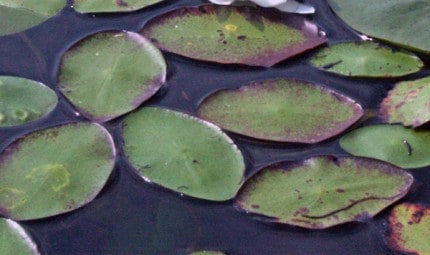
(Chelsea Update would like to thank Tom Hodgson and the Waterloo Natural History Association for the information and photos in this column.)
Take the time to canoe, kayak or fish in the shallows of area lakes that still have some natural shoreline, and you will be rewarded with some of nature’s most beautiful and interesting blossoms.

This is water lily season. Though not true lilies at all, they do produce some impressive flowers. The white or fragrant water lily is the showiest of all with large white blossoms have yellow centers. They are open wide from early morning to early afternoon and then close as if to rest for the next day. Called lily pads because of their large round leaves that float on the surface, they are perfect places for bull frogs or green frogs to sit and wait for unsuspecting insects.
They also shade the shallows from the heat of the sun providing a cool, dark place for large-mouth bass to hide. A well placed lure dropped at the edge of the pads will often result in a nice fat fish for the dinner table.
Fragrant water lily blossoms should be with us all summer. However, individual flowers, once fertilized, are pulled under the water as the stem to which they are attached coils. The seed pod containing many seeds develops under water. The seeds are relished by waterfowl, especially during the fall migration. The leaves and roots are eaten by muskrats, beaver and even deer.

Spadderdock, also known as yellow water lily, blooms at about the same time as fragrant water lily. It prefers slightly shallower water, and its leaves are more heart-shaped and often protrude above the water’s surface. The flowers are bright yellow. The yellow, petal-like sepals that surround the seed-pod are often tinged with burnt-umber. Bullfrogs often hide among the leaves of spadderdock. The yellow throat of the male bullfrog is almost a perfect match for the color of the blossoms.
Could this be a protective coloration developed by the bullfrog for survival? Perhaps only the bullfrog knows. The leaves and roots of spadderdock are also valued by muskrat and beaver, and the seeds by migrating waterfowl.
Another smaller and less conspicuous aquatic plant found floating in the shallows is brasenia or water-shield. Each small, shield-shaped leaf is about 4-inches long, floats on the surface, and is attached to the stem at its center. In late spring and summer the plants send up small purple flowers, each on a single stem. Each flower is about the size of a quarter and lasts only two days.

On the first day it emerges from the water as a female flower. At the end of the day, it submerges back into the water.
On the second day it emerges as a male flower. Pollen from this male flower is spread by the wind to other female flowers in the area. At the end of the second day the flower submerges once again, and the fruit and seeds develop under water. Picking the leaf of brasenia can be a challenge as both the stem and the underside of the leaf are covered with a slippery jelly-like substance. The purpose of this substance is not fully understood, but may be to inhibit munching insects.
All three of these interesting plants can be found in the shallows of Mill Lake in the Waterloo Recreation Area. The public access for Mill Lake is located on McClure Road just west of its intersection with Bush Road.
This is an electric motors only lake, and is a great place to canoe or kayak. The lake is two miles in circumference, and has a totally natural shoreline. Those paddling for distance can measure exactly how far they have gone. Enjoy.
















That is incredible about the flower, male/female! Thank you, Tom,for writing such interesting articles about our area.